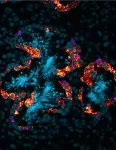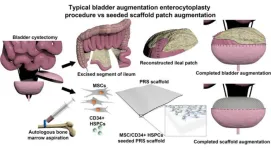(Press-News.org)
SINGAPORE — Scientists have generated a comprehensive map of the gene targets regulated by the transcription factors HNF4A and HNF1A in human pancreatic beta cells and liver cells. Published in the journal Nature Communications, the study revealed common and tissue-specific molecular pathways regulated by HNF4A and HNF1A, two proteins that possess important functions governing the development and function of the pancreas and liver.
Notably, the scientists identified several novel gene targets in pancreatic beta cells, the cells responsible for insulin production, that may play previously unknown roles in regulating insulin secretion. As genetic variants in HNF4A and HNF1A are known to cause a rare form of diabetes called Maturity Onset Diabetes of the Young (MODY) and also influence risk for the more common type 2 diabetes, these findings provide valuable insights into potential therapeutic targets for diabetes.
The research team, led by Dr Adrian Teo, Senior Principal Investigator at A*STAR's Institute of Molecular and Cell Biology (IMCB), used the cutting-edge technique of chromatin immunoprecipitation sequencing (ChIP-Seq) to map the genomic binding sites of HNF4A and HNF1A in stem cell-derived models of human pancreatic and liver cells, and in primary human islets.
By comparing the binding profiles across different cell types, they found that while these two transcription factors regulate some common genes and processes like actin cytoskeleton organization in both pancreatic beta cells and liver cells, they also exhibit tissue-specific binding patterns that correspond to the distinct functions of each cell type. For example, in liver cells, HNF4A preferentially bound to genes involved in cholesterol and fatty acid metabolism.
Zooming in on the pancreatic beta cell targets, the scientists shortlisted several high-confidence genes directly bound and regulated by HNF4A, including HAAO and USH1C, which have not been previously characterized in beta cells. They showed that loss of HAAO or USH1C led to impaired glucose-stimulated insulin secretion in human beta cells, indicating that these genes regulate beta cell function.
Using a similar ChIP-Seq based approach, the study also investigated the molecular impact of a common genetic variant in HNF4A that is associated with type 2 diabetes risk. The scientists found that this variant led to increased binding and activation of a small number of gene targets, suggesting a potential gain-of-function effect at specific gene regions that may influence diabetes predisposition.
“HNF4A and HNF1A are very important diabetes genes known to be regulating insulin secretion but their targets remained unclear,” said Dr Teo, the study’s senior author. “We are excited to further explore some of these novel targets or pathways which may serve as entry points for developing future diabetes therapies," added Dr Teo.
“Our study provides the community with a comprehensive resource for investigating HNF4A and HNF1A gene targets in pancreatic beta cells and liver cells. By identifying key genes regulated by these two transcription factors in a tissue-specific manner, we shed light on their roles in normal tissue function and how their dysfunction may contribute to diabetes,” said Dr Natasha Ng, Senior Scientist at IMCB and the study’s first author.
The team next aims to extend this molecular mapping approach to other diabetes-associated transcriptional regulators and mine the rich dataset to uncover more insights into disease-related mechanisms. They also plan to utilize genome editing tools to correct patient-specific variants in HNF4A and HNF1A to directly probe their effects in human stem cell-derived models.
– End –
For media queries and clarifications, please contact:
Owen Sia
Senior Manager, Corporate Communications
Agency for Science, Technology and Research (A*STAR)
Email: Owen_Sia@hq.a-star.edu.sg
About A*STAR’s Institute of Molecular and Cell Biology (IMCB)
The A*STAR Institute of Molecular and Cell Biology (IMCB) is a premier research institute whose mission is to harness biology for transformational bio-therapeutics and diagnostics. With a strong emphasis on collaboration with stakeholders across the ecosystem in Singapore, IMCB aims to achieve scientific excellence and continues to nurture the next generation of scientists in order to create growth and enhance lives. For more information about IMCB, please visit www.a-star.edu.sg/imcb.
About the Agency for Science, Technology and Research (A*STAR)
The Agency for Science, Technology and Research (A*STAR) is Singapore's lead public sector R&D agency. Through open innovation, we collaborate with our partners in both the public and private sectors to benefit the economy and society. As a Science and Technology Organisation, A*STAR bridges the gap between academia and industry. Our research creates economic growth and jobs for Singapore, and enhances lives by improving societal outcomes in healthcare, urban living, and sustainability. A*STAR plays a key role in nurturing scientific talent and leaders for the wider research community and industry. A*STAR’s R&D activities span biomedical sciences to physical sciences and engineering, with research entities primarily located in Biopolis and Fusionopolis. For ongoing news, visit www.a-star.edu.sg.
Follow us on
Facebook | LinkedIn | Instagram | YouTube | TikTok
END
More than 100,000 oil and gas wells across the western U.S. are in areas burned by wildfires in recent decades, a new study has found, and some 3 million people live next to wells that in the future could be in the path of fires worsened by climate change.
Researchers from the University of California, Berkeley, said their analysis, which was published last week in the journal One Earth, is the first to examine historical and projected wildfire threats on oil and gas facilities in the U.S. While the public health effects of scorched and damaged drill sites are unclear, researchers said the study is a necessary step ...
DALLAS, JUNE 25, 2024 — Cardiovascular disease is the leading cause of death for women, and gaps in care and access persist between women and men. Addressing those gaps could lead to an increase of at least 1.6 million years of quality life and boost the U.S. economy by $28 billion annually by 2040, according to a new report published today by the American Heart Association and the McKinsey Health Institute (MHI). To help close these gaps and foster gender specific cardiovascular disease science into implementation, the Association, observing 100 years of lifesaving service as the world’s leading nonprofit organization ...
(Santa Barbara, Calif.) — Computers have come so far in terms of their power and potential, rivaling and even eclipsing human brains in their ability to store and crunch data, make predictions and communicate. But there is one domain where human brains continue to dominate: energy efficiency.
“The most efficient computers are still approximately four orders of magnitude — that’s 10,000 times — higher in energy requirements compared to the human brain for specific tasks such as image processing and recognition, although they outperform the brain in tasks like mathematical calculations,” said UC Santa Barbara ...
Biogenic monoamines — molecules like dopamine and serotonin — are famous for their role as the brain’s emissaries of mood, learning and memory, stress mechanisms, and fight-or-flight responses in the body.
But these neurotransmitters existed in nature long before brains popped up in the evolutionary tree. They’re prevalent in plants, bacteria, and single-cell organisms as well, but their functions there are far less understood.
Scientists at the Morgridge Institute for Research have added another task for ...
DURHAM, N.C. -- There’s a strong chance that last week’s scorching temperatures were even hotter than reported for those living in underserved urban areas.
It’s been well established that more impoverished areas within cities are typically hotter than their wealthier neighborhoods. Dubbed “urban heat islands,” these communities have more buildings, less vegetation and somewhat higher population density, which combine to produce the heating effect.
New research from environmental engineers at Duke University has shown that citizen science tools used to gauge heat in these ...
A functional, healthy bladder is something that many of us take for granted. Yet millions of Americans deal with bladder issues, ranging from temporary inconveniences to long-lasting conditions. While many bladder disorders can be managed with non-invasive solutions, some conditions may require surgery to restore bladder function.
In patients with major bladder issues, a cystectomy may need to be performed. In this procedure, some or all of the bladder is removed (reasons for this may include acute trauma or bladder cancer). Sometimes, to compensate for the loss of tissue, the bladder is augmented (made larger), typically with ...
American Geophysical Union
Press Release 24-27
For Immediate Release
25 June 2024
This press release is available online at: https://news.agu.org/press-release/worlds-lakes-less-resilient-climate-pollution/
AGU press contact:
Rebecca Dzombak, news@agu.org (UTC-4 hours)
Contact information for the researchers:
Ke Zhang, Chinese Academy of Sciences, kzhang@niglas.ac.cn (UTC+8 hours)
WASHINGTON — Nearly half of the world’s large lakes have lost resilience, or the ability to bounce back after an abrupt disturbance, in recent ...
Vanderbilt University Medical Center (VUMC) researchers are touting data from a multicenter, international phase 2 clinical trial showing a new, curative treatment for sickle cell disease (SCD).
The therapy, nonmyeloablative haploidentical bone marrow transplant (BMT) with thiotepa and posttransplant cyclophosphamide (PTCy), is proving to have equivalent efficacy and one-fifth the cost as recently FDA-approved myeloablative gene therapy options, according to Michael DeBaun, MD, MPH, director of the Vanderbilt-Meharry Center ...
In a significant finding, researchers from The Jackson Laboratory (JAX) and UConn Health have discovered that sodium valerate, a short-chain fatty acid produced by gut microbes, can dramatically reduce binge drinking behavior and blood ethanol concentration in mice. The study, reported June 17 in Microbiome, offers promising insights into the gut-brain axis and presents a novel therapeutic approach for excessive alcohol use.
We are interested in physiological addiction genetics and genomics to identify new drug targets for treating addiction/overdose.
The research team, led by Yanjiao Zhou, M.D., ...
Chocolate-flavored pills for children who hate taking medicine.
Several drugs combined into one daily pill for seniors who have trouble remembering to take their medications.
Drugs printed at your local pharmacy at personalized dosages that best suit your health needs.
These are just a few potential advantages of 3D drug printing, a new system for manufacturing drugs and treatments on-site at pharmacies, health care facilities and other remote locations.
In 2015, the Food and Drug Administration approved the first 3D-printed drug, Spritam ...





